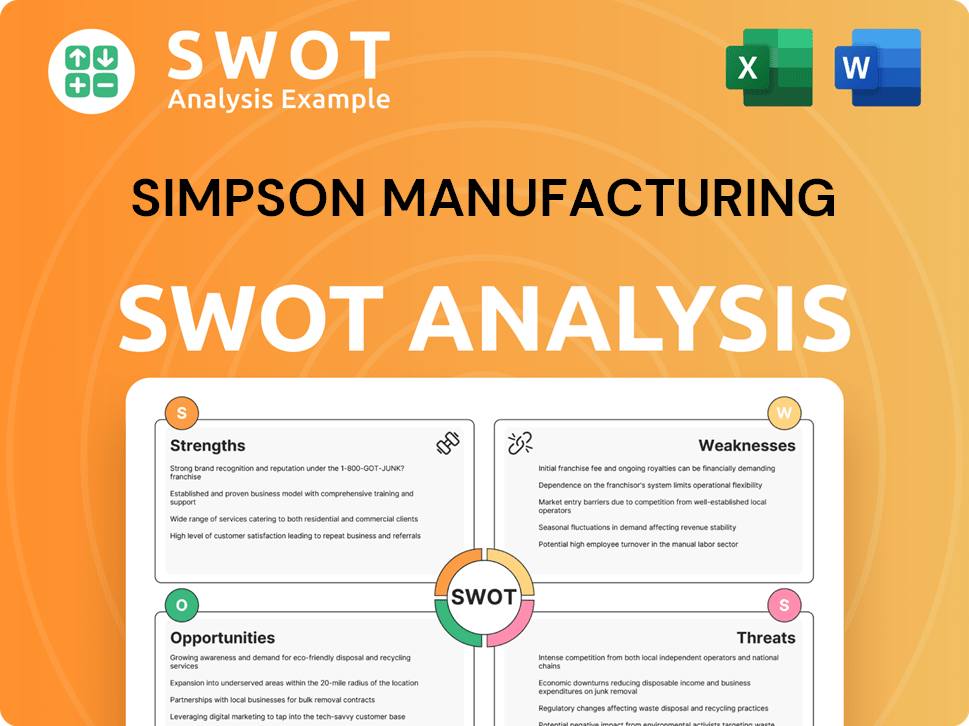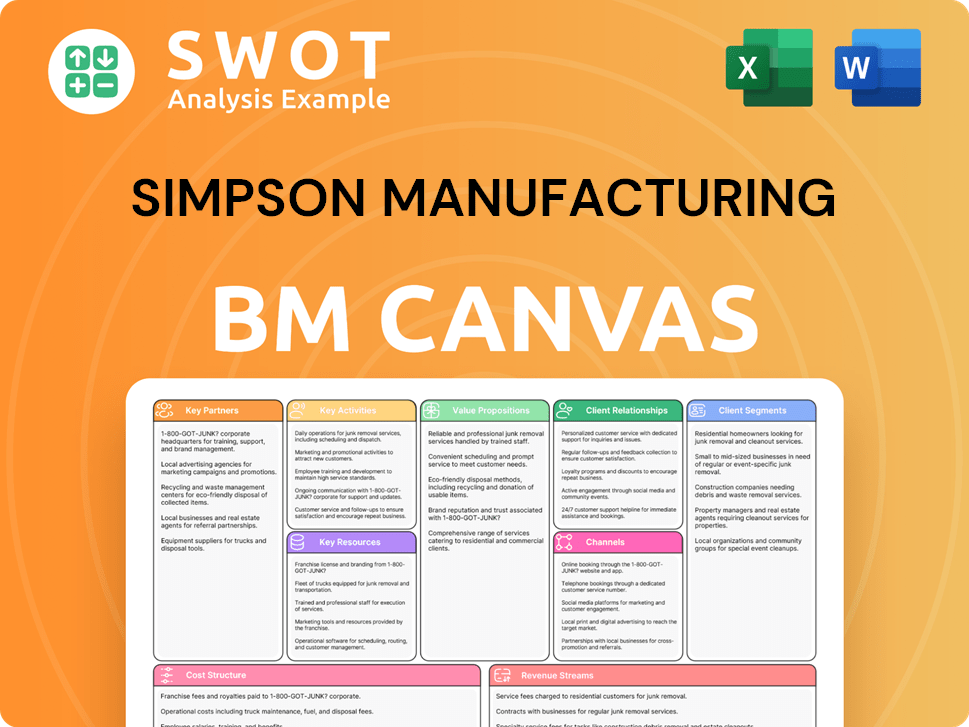Simpson Manufacturing Bundle
Who Really Controls Simpson Manufacturing Company?
Understanding a company's ownership is crucial for investors and stakeholders alike. It unlocks insights into a company's strategic direction, governance, and potential for growth. This analysis dives into the ownership structure of Simpson Manufacturing Company, a leader in building solutions, to reveal the forces shaping its future.

Simpson Manufacturing Company's journey, from its roots in 1956 to its current market position, is a testament to strategic evolution. As a public company (NYSE: SSD) with a market capitalization of $6.75 billion as of June 10, 2025, understanding the Simpson Manufacturing SWOT Analysis is essential. This exploration will uncover the key players behind Simpson Strong-Tie, from its founder to its current shareholders, offering a comprehensive view of its ownership dynamics. This sheds light on the company's history and future.
Who Founded Simpson Manufacturing?
The roots of Simpson Manufacturing Co., Inc. trace back to 1956, when Barclay Simpson established the company in Oakland. This marked the continuation of his father's window screen business, with Barclay at the helm. The early years were pivotal in shaping the company's future direction.
While specific details about early investors or the initial distribution of shares are not publicly available, it's known that Barclay Simpson held a significant portion of the company. His leadership and vision were instrumental in the early success of the company.
Barclay Simpson's vision for Simpson Manufacturing was to innovate in the building materials sector, especially in structural connectors. This strategic focus laid the groundwork for the company's subsidiary, Simpson Strong-Tie Co. Inc., to become a leading producer of structural connectors in North America and Europe. The company's early focus on manufacturing joist hangers was a key step in this direction.
Barclay Simpson founded the company in 1956 in Oakland, California. He was the driving force behind the company's early vision and operations.
Barclay Simpson was the largest individual shareholder. He owned approximately 8.70 million shares at one point, representing 20.80% of the company.
The company initially focused on manufacturing joist hangers. This early focus was a key step in the company's evolution.
Barclay Simpson's vision was to lead in the building materials sector. This vision drove the company's strategic direction.
The company's early values included a 'Long-Range View,' suggesting a focus on sustained growth. This approach helped shape the company.
Public records do not detail early agreements such as vesting schedules or founder exits. Information on early ownership disputes is not available.
Understanding the early ownership and vision of Simpson Manufacturing Company provides valuable insights into its long-term success. The company's focus on innovation and its strategic direction, guided by Barclay Simpson, were crucial. Here are some key points regarding Simpson Manufacturing Company ownership and its early history:
- Barclay Simpson founded the company and was the largest shareholder.
- The company initially focused on manufacturing joist hangers.
- The early vision was to lead in the building materials sector.
- The company's values included a 'Long-Range View,' emphasizing sustained growth.
- Public records do not detail early agreements or disputes.
Simpson Manufacturing SWOT Analysis
- Complete SWOT Breakdown
- Fully Customizable
- Editable in Excel & Word
- Professional Formatting
- Investor-Ready Format

How Has Simpson Manufacturing’s Ownership Changed Over Time?
The evolution of ownership at Simpson Manufacturing Co., Inc. (NYSE: SSD) reflects its journey from a private entity to a publicly traded company. Celebrating its 30th year on the New York Stock Exchange in 2024, the company's ownership structure has significantly transformed, with a shift towards institutional investors. This transition has been a key factor in shaping the company's strategic direction and financial performance, as highlighted in the Brief History of Simpson Manufacturing.
As of June 10, 2025, the market capitalization of Simpson Manufacturing stood at $6.75 billion, with approximately 42 million shares outstanding. The ownership landscape is dominated by institutional investors, who collectively hold about 92.65% of the company's stock. Insiders own a small portion, around 0.31%, while public companies and individual investors account for 7.04%. This structure underscores the confidence institutional investors have in the long-term prospects of Simpson Manufacturing and its ability to generate value.
| Shareholder | Shares Held (as of March 31, 2025) | Percentage of Ownership |
|---|---|---|
| Kayne Anderson Rudnick Investment Management LLC | 4,534,724 | N/A |
| Vanguard Group Inc. | 4,177,097 | N/A |
| BlackRock, Inc. | 3,944,887 | N/A |
Key institutional shareholders play a significant role in shaping the company's trajectory. As of March 31, 2025, Kayne Anderson Rudnick Investment Management LLC, Vanguard Group Inc., and BlackRock, Inc. are among the top institutional holders. Other significant investors include JPMorgan Chase & Co., Fmr LLC, Morgan Stanley, and State Street Corp. These major stakeholders influence corporate strategy through their voting power and engagement in corporate governance. Furthermore, Barclay Simpson remains a notable individual shareholder, holding 8.70 million shares, which were valued at approximately $1.37 billion. The company's focus on generating cash flow from operations, with $338.2 million in 2024, supports investments and returns capital to shareholders through dividends and share repurchases, reflecting a commitment to shareholder value.
The ownership structure of Simpson Manufacturing Company, with its significant institutional holdings, shows a stable and investor-focused approach.
- Institutional investors hold the majority of shares, indicating confidence in the company's future.
- Key institutional shareholders include Kayne Anderson Rudnick, Vanguard, and BlackRock.
- Barclay Simpson remains a significant individual shareholder.
- The company's financial performance, including cash flow generation, supports shareholder value.
Simpson Manufacturing PESTLE Analysis
- Covers All 6 PESTLE Categories
- No Research Needed – Save Hours of Work
- Built by Experts, Trusted by Consultants
- Instant Download, Ready to Use
- 100% Editable, Fully Customizable

Who Sits on Simpson Manufacturing’s Board?
The current Board of Directors of Simpson Manufacturing Co., Inc. plays a crucial role in the company's governance and strategic oversight. As of May 2025, the board includes eight members. Philip E. Donaldson serves as the Chairman of the Board, a position he took on in May 2024. Other board members include James S. Andrasick, Chau Banks, Felica Coney, Angela Drake, Celeste Volz Ford, Kenneth D. Knight, and Michael Olosky, who also serves as the President and CEO. Understanding the Competitors Landscape of Simpson Manufacturing can offer additional insights into the company's position.
A significant aspect of Simpson Manufacturing's governance is the independence of its board. The 2025 proxy statement highlighted that 7 out of 8 directors are independent, and 50% of the directors are female, assuming all nominees are elected. Angela Drake was appointed as an independent director effective January 1, 2025, bringing extensive financial leadership experience to the board.
| Board Member | Title | Independent Director |
|---|---|---|
| Philip E. Donaldson | Chairman of the Board | Yes |
| Michael Olosky | President and CEO | No |
| James S. Andrasick | Director | Yes |
| Chau Banks | Director | Yes |
| Felica Coney | Director | Yes |
| Angela Drake | Director | Yes |
| Celeste Volz Ford | Director | Yes |
| Kenneth D. Knight | Director | Yes |
Regarding voting structure, each share of common stock generally has one vote for each director nominee and one vote for other proposals. The company's bylaws state that a director is elected if the votes cast 'for' their election exceed the votes cast 'against' their election, a majority vote. However, in a contested election with a properly nominated opposing candidate, a plurality vote applies, where candidates receiving the highest numbers of affirmative votes are elected. There are no indications of dual-class shares, special voting rights, or golden shares that would grant outsized control to specific individuals or entities beyond their shareholding. The company's commitment to shareholder democracy is evident through its historical engagement on governance matters.
The board consists of eight members, with a majority being independent and a significant representation of female directors.
- The Chairman of the Board is Philip E. Donaldson.
- Michael Olosky serves as President and CEO.
- Each share of common stock has one vote, with a majority vote standard for director elections.
- The company has a history of engaging with shareholders on governance matters.
Simpson Manufacturing Business Model Canvas
- Complete 9-Block Business Model Canvas
- Effortlessly Communicate Your Business Strategy
- Investor-Ready BMC Format
- 100% Editable and Customizable
- Clear and Structured Layout

What Recent Changes Have Shaped Simpson Manufacturing’s Ownership Landscape?
Over the past few years, Simpson Manufacturing Company ownership has been marked by strategic financial decisions and leadership adjustments. The company has actively managed its capital, primarily through share repurchases and consistent dividend payments. In 2024, Simpson Manufacturing repurchased approximately 559,000 shares of its common stock for $100 million. The Board authorized an additional repurchase of up to $100.0 million of common stock, effective from January 1, 2025, through December 31, 2025. For the first quarter of 2025, the company repurchased $25.0 million in common stock.
Leadership changes have also played a role in shaping the company's trajectory. In May 2024, Udit Mehta was appointed as Chief Technology Officer, and in June 2024, Matt Dunn became Senior Vice President, Finance, later appointed Chief Financial Officer and Treasurer effective January 1, 2025. These appointments reflect the company's commitment to strengthening its strategic and financial management capabilities. Dividends have also been a consistent part of the company's financial strategy, with a quarterly cash dividend of $0.28 per share declared in late 2024 and paid on January 23, 2025.
| Metric | Details | Year |
|---|---|---|
| Net Sales | $2.2 billion | 2024 |
| Operating Income Margin | 19.3% | 2024 |
| Earnings Per Diluted Share | $7.60 | 2024 |
| Capital Expenditures (Projected) | $150 million to $170 million | 2025 |
From an ownership perspective, institutional investors continue to hold a significant stake in Simpson Manufacturing. As of May 2025, institutional investors hold approximately 99.93% of the company's stock, with mutual funds holding around 74.65%. This high level of institutional ownership underscores the confidence in the company's performance and future prospects, despite market challenges. Simpson Manufacturing's focus remains on facility expansions and production efficiencies, with anticipated capital expenditures between $150 million and $170 million in 2025.
Institutional investors own the vast majority of Simpson Manufacturing's stock. Mutual funds are a significant part of this, showcasing confidence. The company's financial decisions, like stock repurchases, also reflect its strategic approach.
Recent appointments, such as the Chief Technology Officer and CFO, highlight the company's focus on strengthening its leadership. These changes support Simpson's strategic direction and financial management. These appointments are a sign of the company's commitment.
Simpson Manufacturing reported $2.2 billion in net sales for 2024. The company is projecting significant capital expenditures for 2025. The operating income margin was 19.3% in 2024.
Institutional investors hold approximately 99.93% of Simpson's stock as of May 2025. This strong institutional presence demonstrates confidence in the company's strategic direction. Mutual funds hold a significant portion of the company's shares.
Simpson Manufacturing Porter's Five Forces Analysis
- Covers All 5 Competitive Forces in Detail
- Structured for Consultants, Students, and Founders
- 100% Editable in Microsoft Word & Excel
- Instant Digital Download – Use Immediately
- Compatible with Mac & PC – Fully Unlocked

Related Blogs
- What are Mission Vision & Core Values of Simpson Manufacturing Company?
- What is Competitive Landscape of Simpson Manufacturing Company?
- What is Growth Strategy and Future Prospects of Simpson Manufacturing Company?
- How Does Simpson Manufacturing Company Work?
- What is Sales and Marketing Strategy of Simpson Manufacturing Company?
- What is Brief History of Simpson Manufacturing Company?
- What is Customer Demographics and Target Market of Simpson Manufacturing Company?
Disclaimer
All information, articles, and product details provided on this website are for general informational and educational purposes only. We do not claim any ownership over, nor do we intend to infringe upon, any trademarks, copyrights, logos, brand names, or other intellectual property mentioned or depicted on this site. Such intellectual property remains the property of its respective owners, and any references here are made solely for identification or informational purposes, without implying any affiliation, endorsement, or partnership.
We make no representations or warranties, express or implied, regarding the accuracy, completeness, or suitability of any content or products presented. Nothing on this website should be construed as legal, tax, investment, financial, medical, or other professional advice. In addition, no part of this site—including articles or product references—constitutes a solicitation, recommendation, endorsement, advertisement, or offer to buy or sell any securities, franchises, or other financial instruments, particularly in jurisdictions where such activity would be unlawful.
All content is of a general nature and may not address the specific circumstances of any individual or entity. It is not a substitute for professional advice or services. Any actions you take based on the information provided here are strictly at your own risk. You accept full responsibility for any decisions or outcomes arising from your use of this website and agree to release us from any liability in connection with your use of, or reliance upon, the content or products found herein.